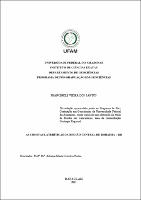| ???jsp.display-item.social.title??? |


|
Please use this identifier to cite or link to this item:
https://tede.ufam.edu.br/handle/tede/3274| ???metadata.dc.type???: | Dissertação |
| Title: | As crostas lateríticas da região central de Roraima - RR |
| ???metadata.dc.creator???: | Santos, Francinele Vieira dos  |
| ???metadata.dc.contributor.advisor1???: | Horbe, Adriana Maria Coimbra |
| ???metadata.dc.description.resumo???: | As crostas lateríticas, que representam os relictos das transformações paleoclimáticas especialmente entre o Cenozóico e o Recente, permitem inferir as condições e a evolução do intemperismo na região intertropical da Terra. Na borda do Cráton das Guianas, região central de Roraima, se desenvolveu o Grabén do Tacutu, onde afloram crostas lateríticas. Essa área cratônica foi reativada no Plioceno o que propiciou intensa erosão ao tornar a região tectonicamente instável. Com o objetivo de determinar as implicações desse ambiente no intemperismo das rochas do embasamento do Cráton das Guianas, foi selecionada a região de Mucajaí onde ocorrem a Serra da Prata e com menor expressão a Serra da Moça. Essas feições de relevo fazem parte do Pediplano Rio Branco-Rio Negro, e seu entorno rebaixado, do Planalto Dissecado Norte da Amazônia. Foram estudadas as rochas, as crostas e os solos da região com base em levantamento de campo dos litotipos e na caracterização dos aspectos texturais, mineralógicos e geoquímicos. Foram analisados os óxidos maiores e menores (SiO2, Fe2O3, Al2O3, K2O, Na2O, CaO, MgO,TiO2, P2O5, PF) os elementos traços (Mn, Zr, V, Ni, Cu, Zn, Sc, Co, Ga, Cr, Y, Th, Hf, Nb, Ta, Ba, Mo, Sr, Rb, Cs, U, W, As, Au, Ag, Hg, Ge, In, Li, Sb, Se, Te, Tl e ETR) e isótopos de Pb. As crostas lateríticas desenvolveram-se a partir de charnockítos, gabros, granitos e gnaisses. São do tipo protopisolíticas a pisolíticas no topo da Serra da Prata e vermiformes nas porções rebaixadas, ambas recobertas por solos argiloarenosos marrom avermelhados. As crostas lateríticas são friáveis com abundante matriz argilosa, com predominância de goethita sobre hematita, e baixo conteúdo de gibbsita, portanto são pouco evoluídas, destacando-se apenas por seus conteúdos de Fe2O3, PF, Co, Cr, Ga, Zn, Mn e W, enquanto as rochas se diferenciam pela associação SiO2, Na2O, K2O, Ba, Rb, Tl, Y, Mo, ETR (-La e Eu). Apesar das razões isotópicas de Pb indicarem que as crostas lateríticas tiveram proveniência a partir do charnoquito, os dados geoquímicos mostraram maior afinidade entre essas e as rochas mais abundantes (granito, charnoquito e gnaisse), devido suas similaridades químicas. O desenvolvimento destas crostas marca a evolução quaternária da paisagem após a reativação tectônica da região no Mioceno. |
| Abstract: | The lateritic crusts, which represent the relict of paleoclimatic changes especially between the Cenozoic and the Recent, allow inferring the conditions and the evolution of weathering in the intertropical region of the Earth. At the edge of the Guianas Shield, in the central region of Roraima, where occur lateritic crusts outcropping, has developed the Graben of the Tacutu. It`s reactivation in the Pliocene caused severe erosion what the region tectonically unstable. With the objective to determine the implications of that environment in the weathering of the basement rocks from the Guiana Shield, the region of Mucajai was selected to where it is situated the Serra da Prata and to a less extent the Serra da Moça. These relief features are inserted in the Piedmont Rio Branco-Rio Negro, and its surroundings lowered portion on the Dissected Plateau North of the Amazonas. Rocks, crusts and soils of the region were studied on basis of field survey of the lithotypes and their textural, mineralogical and geochemical characterization. The major oxides, the trace elements (Mn, Zr, V, Ni, Cu, Zn, Sc, Co, Ga, Cr, Y, Th, Hf, Nb, Ta, Ba, Mo, Sr, Rb, Cs, U, W, As, Au, Ag, Hg, Ge, In, Li, Sb, Se, Te, Tl and ETR) and the Pb isotopes were analyzed. The lateritic lithotypes developed from charnockites, gabbro, granites and gneisses. Crusts of protopisoliticas and pisoliticas types were formed at the top of the Serra da Prata and vermiform in the lower portions of the landscape which are cover by clay-sandy reddish brown soils. The crusts are immature, friables with abundant clay matrix, composed mainly of goethite and hematite, and low content of gibbsite. The rocks are distinguished by SiO2, Na2O, K2O, Ba, Rb, Tl, Y, Mo, REE (La-and Eu) association, while the lateritic rocks by Fe2O3, PF, Co, Cr, Ga, Zn, Mn, W . There is a greater geochemical affinity between the crusts and soils with granite, charnockite and gneiss than with the gabbro, as they are the most abundant rocks and also because they have little chemical variation; however, the Pb isotopic ratios indicate provenance from the charnockite. The development of these crusts marks the Quaternary landscape evolution of the central portion of Roraima after the tectonic reactivation in the Miocene. |
| Keywords: | Evolução da paisagem Crostas lateríticas Cráton das Guianas Landscape evolution |
| ???metadata.dc.subject.cnpq???: | CIÊNCIAS EXATAS E DA TERRA: GEOCIÊNCIAS |
| Language: | por |
| ???metadata.dc.publisher.country???: | BR |
| Publisher: | Universidade Federal do Amazonas |
| ???metadata.dc.publisher.initials???: | UFAM |
| ???metadata.dc.publisher.department???: | Instituto de Ciências Exatas |
| ???metadata.dc.publisher.program???: | Programa de Pós-graduação em Geociências |
| Citation: | SANTOS, Francinele Vieira dos. As crostas lateríticas da região central de Roraima - RR. 2011. 43 f. Dissertação (Mestrado em Geociências) - Universidade Federal do Amazonas, Manaus, 2011. |
| ???metadata.dc.rights???: | Acesso Aberto |
| URI: | http://tede.ufam.edu.br/handle/tede/3274 |
| Issue Date: | 29-Jun-2011 |
| Appears in Collections: | Mestrado em Geociências |
Files in This Item:
| File | Description | Size | Format | |
|---|---|---|---|---|
| Dissertação - Francinele Vieira dos Santos.pdf | Dissertação - Francinele Vieira dos Santos.pdf | 3.18 MB | Adobe PDF |  Download/Open Preview |
Items in DSpace are protected by copyright, with all rights reserved, unless otherwise indicated.




